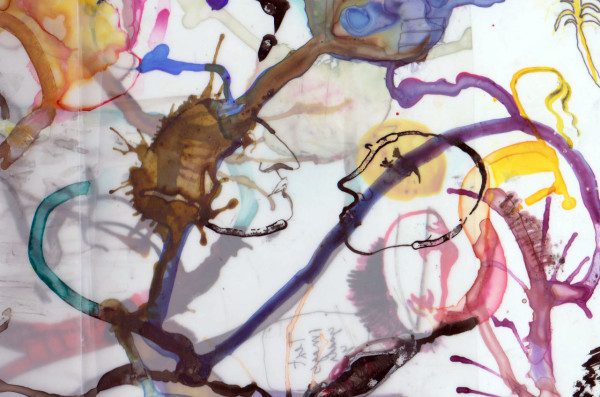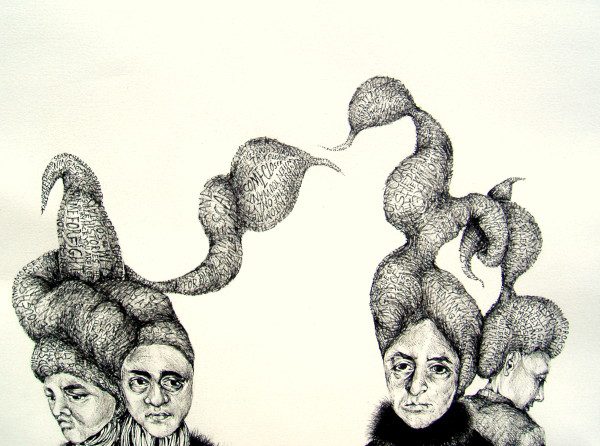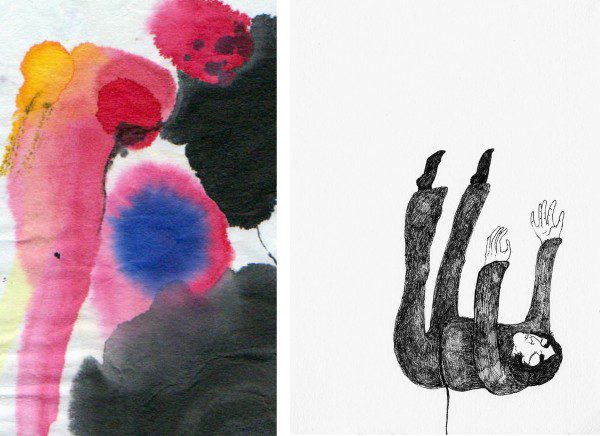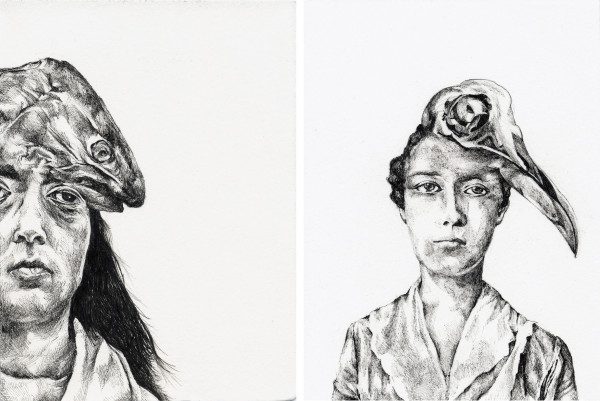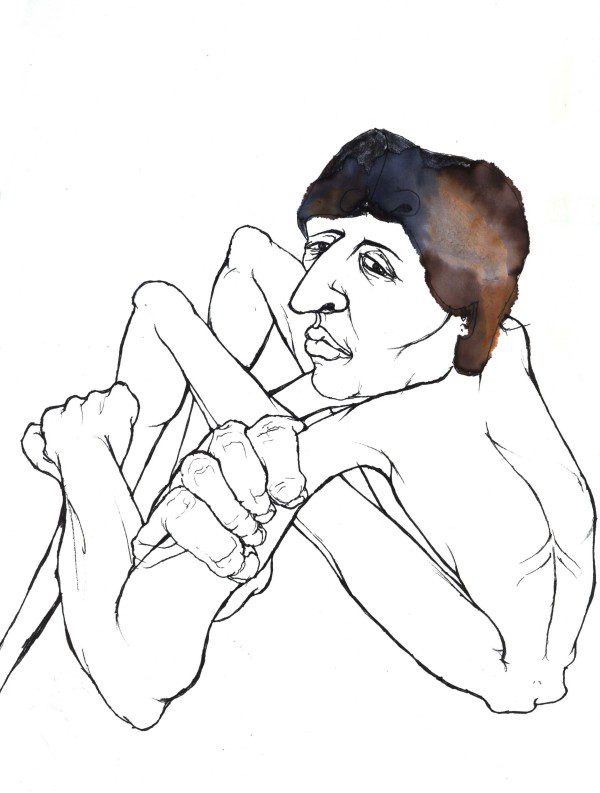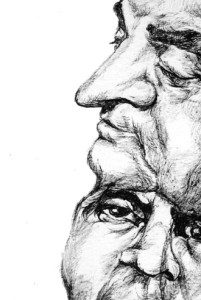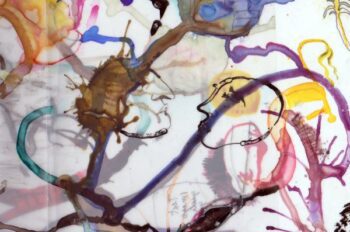
On rainy nights in the drawing studio, I looked up at the blur running down the wall of windows that slanted toward the courtyard two stories below. The college gave art students 24-hour access to the building, so I spent many nights of my undergraduate years working on assignments there. Rats scurried across the beams above, finding their way into the cabinets where students stored newsprint pads. (In class, we pulled them onto our easels and found the corners of our sketches nibbled through.) All night, I’d waver between calm and frenzy, kneeling before an incomplete drawing, surrounded by tubes of paint, cups of murky water, and pages torn from my sketchbook.
I learned how to draw in this room, which is to say: I learned how to see. Drawing requires seeing in new ways, and on a good day blinking refreshes sight and brings clarity. My mind has always wandered; I have difficulty staying on point. Drawing demands that I pay attention to the lines and shapes that morph between the fore- and backgrounds, to how light falls on any subject, to the time of day. Now I notice the angle of a twisted shoulder or the steep, dipping edge of a rooftop or the colors of a dead baby bird.
My drawing professor introduced our class to brushes made with sable or synthetic hairs, taught us how leaving them in jars of water wrecked them, and showed us how to loosen the pigment caught in the fibers. She sent us to buy a set of proper drawing pencils, then demonstrated the gradations of texture and density available to us. And when we were restless, she led us out of the studio to collect twigs in the campus gardens. We dipped our new drawing tools into ink jars and learned about line quality.
On Sundays, a handful of students spent hours working in the studio, often not emerging until Monday morning. The unswept, cold, cement floors were covered in pencil shavings and a layer of charcoal dust. Sometimes our professor stopped by with her German shepherd, who stole bites of our donuts and trampled our drawings with her charcoal-covered paws, knocking into Sally, the she-skeleton on wheels who assisted with our anatomy lessons. The industrial steel sinks were stained with paint. Ink seeped into our fingernails, shadows and light shifted, and the same scratched Al Green CD played six times on repeat before someone noticed and yanked the plug from its socket.
Once, our professor took us to Huntington Gardens in Pasadena, hoping we’d find inspiration in desert flora. “Look carefully,” she instructed. “Every plant is a living system. If you take your time, you’ll be amazed at what you’ve never noticed before.” I remember walking through gardens and greenhouses, sketching cactus thorns and examining the curls on the petal of an orchid and touching fine layers of fuzz on rose stems. Waxy succulents bulged with water, and I felt a thrill from my new awareness of a plant body’s surface and interior worlds, of the shape and parts of a living thing.
Another afternoon, we walked into town, and she treated us to ice cream on the condition that we stop to speak to the sculptor carving a block of marble in a nearby park. He welcomed our company and showed us the tools he used to chisel stone. Thin shards of pearly white rock fell away from the mass. Our teacher gave us exercises in seeing, and with steady and diligent practice, I developed a new way of receiving and interpreting visual information.
Relaying this information to the page, on the other hand, can be a maddening and meandering process. In my first year of college, I discovered phthalo blue, a particularly imperious pigment that threatened to dominate any page it met. I did a quick wash of water across a piece of paper, dabbed the tip of my brush into the paint and placed it to the page. It bled immediately, rushing to the edges of the wet area, pooling and darkening there. I was struck by its intensity, and in my struggle to understand its properties, nearly every drawing I did that semester was infused with the same deep-ocean blue. It invaded my drawings, obliterating any subtle gestures I’d managed to make.
In addition to exploring technique, most art classes require a critical component as well. On critique day, my classmates and I nervously pinned our work to the studio walls for public scrutiny. I put up a piece in which I’d twirled and dripped ink to create a barbed wire fence against a watery blue landscape, in hopes of illustrating a hostile barrier to a peaceful place.
“You’ve never seen barbed wire, have you?” my teacher said before the entire class. “These lines are too soft. They’re not threatening at all.”
My eyes grew hot and my throat closed up. I managed to shake my head, embarrassed that I had settled for mere photographs of the subject.
“I can tell,” she continued. “The spikes are beautifully rendered, but they don’t have the effect you intended. The fence and the background have the same quality.” She instructed me to visit the dump in town. “There’s barbed wire there. Take a closer look and then try this again.”
One classmate presented half a dozen homemade journals she had assembled, each filled with sketches drawn daily from the same seat in a cafe. Our teacher praised the energetic drawings but criticized the shabby construction of the books themselves. “If you want us to look at your drawings with care, you can’t put them in a carelessly made vessel.” On the floor, my classmate wept.
Our teacher sighed. “Come on, now. There’s no use in crying.” She emphasized that we would not get it right the first time. “That’s why you’re in this class. Come by my office. I have resources on bookbinding that I can walk you through.”
I was unaccustomed to putting myself in this exposed position on a weekly basis, but it was through these sessions that I learned the practice of looking at work openly, on its own terms. I learned how to articulate with kindness and specificity what I saw in a drawing, whether it was successful or confusing, technically adept or sloppy, moving or clichéd. Most of all, I began to understand the importance of vulnerability, which I’ve come to believe is anybody’s best offering. There was a nakedness to class—a stripping down to the bare marks on the page, a requirement of intimacy, permission to look closer while bearing no weapons. This approach was not easy, but lowering my guard each week was not as difficult as I had expected.
Our drawings came from places of obsession and concern, whether they examined relationships, land, philosophy, politics, culture, or some other new truth we undergraduates had encountered. Siobhan brought an eight-foot-long roll of paper to critique one afternoon, unrolled it and pinned it up with four tacks. I sat on the filthy cement floor of the studio, looking up at her piece—a life-size, nude self-portrait in pencil. Her eyes blazed out from her disproportionate head and the rest of her body—strong rugby thighs, a soft midsection, and tiny feet—floated uncertainly in open space. The drawing was imperfect and raw. It was stunning. That same semester, Daniel hung up his drawing of androgynous young bodies suspended in air in an intricate bubble world. His weightless, unidentifiable figures and imagined landscape created a shared mood of curiosity and melancholy in the studio. That feeling persisted through the semester, and I can still access it now.
I often remember Valerie’s examination of public and private spheres. She drew people in spaces where they considered themselves to be alone but removed the barriers that made those spaces private. In fluid black lines, she drew figures in driving positions, plotted on highways but without the actual cars. She drew people in public bathrooms, seated midair beside each other with their pants around their ankles and no stall walls to separate them. Even now, more than ten years later, I remember her ideas about how we move through shared space, how we protect ourselves from the people close to us. I see her drawings in my head when I ride buses or hurry down densely populated streets where everyone wears headphones and walks alone.
By the end of each semester, because of the intimate subject matter and the regular critiques, I felt closer to classmates I’d never spent time with outside of class than I did to my roommates. This willing and open defenselessness may be the most worthwhile thing a person can give in a culture so often steeped in dishonesty, so obsessed with trends, busy-ness, and sensation. I’ve come to see drawing as a noble branch of expression that values—or even requires—a careful commitment of thought and time. I have struggled to be as generous and sensitive in other parts of my life.
***
What is drawing? There have been many attempts to pin down the essence of the form. Is drawing restricted to pen and ink, graphite, and charcoal? What about pieces that include paint? Does the shape of the surface matter? If an artist draws lines on beach sand, does that count? What about contemporary works done with thread, dirt, smoke, or blood? The definition that resonates most with me—and is the most inclusive—is this: Drawing is intentional mark-making.
I love this: intention and mark-making. Drawing has to do with stains and body movement and ideas and a desire to communicate something internal. It is a flawed attempt at representation. It is a tactile, touchable manifestation of the interior.
I remember the first time I ever loved a hard charcoal line, was moved by it, moved away from my inclination toward the ephemeral, light, extra fine, and faint. I felt the power and beauty of a substantial mark. I love smears of graphite on soft paper, like silvery bruises on blank skin. I love to test how much water a sheet of paper can hold, to inundate it with diluted washes of color, to cast a foundation for some emerging vision. I could stare at my friend’s drawings of equine fetuses for hours, studying her manipulation of color and ruminating on her decision to depict horses in utero. In museums, my heartbeat quickens as I stand as close as I can to van Gogh’s drawings, risking reprimands from guards in order to examine the endless layers of curling, black brushstrokes.
Drawing contains so much possibility, beyond conventional portraits and landscapes done in Conté crayon or fine point. Accessibility is built in. Painters need space, oils and acrylics, brushes, easels, canvases, storage. Photographers need darkrooms, light stands, reflectors, backdrops, film, photo paper, software—an entire collection of equipment. But drawing requires no expensive, cumbersome materials (though it does not exclude them, either). I’ve drawn on coffee cups, receipts, notebooks, cardboard scraps, and hands. On long trips, I exchange a few preferred pens and a sketchbook for found utensils and surfaces. In one series of works, Andy Goldsworthy packs leaves, twigs, and dirt into snowballs, then leaves them to melt on pieces of paper. Once the water has evaporated, the warped and stained result is a drawing—intentional mark-making.
There is a simple and fundamental beauty in seeing a person’s intimate intention, of being invited to look at and participate in the physical proof of someone’s ideas, regardless of how succinct or subtle the work is. Ultimately, my hope in any artistic endeavor—whether drawing, writing, or playing music—is to connect. Art making can be a dialogue or, at the very least, a request for just a moment of thoughtfulness outside of someone’s familiar territory.
***
My final assignment that last college semester was to do a drawing based on an imagined city or community with a made-up set of rules about how it functioned. What I saw immediately—and what remains in my head undrawn—was a network of people with clouds of black thread above their heads, who, in the process of crossing paths, became entangled. A few lonely citizens walked around with neat bundles floating above them, but the majority of people had knotted, frayed messes that followed them around, catching on the messes of passersby. The population was knotted together, snagging and pulling and reeling. In this community, there was a system of crossroads, and everyone had an observable relationship to one another. I planned to use a finely sharpened charcoal pencil to draw the tangles, blurring the denser areas with a cloth or tortillon.
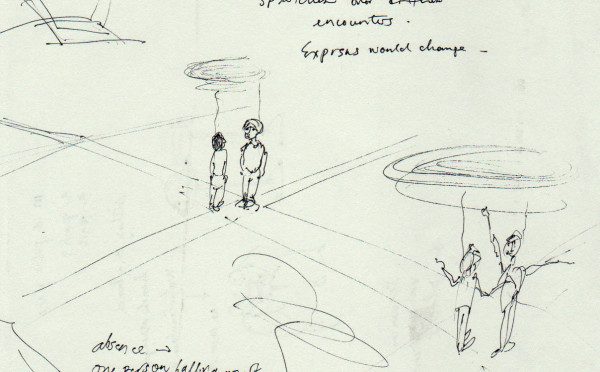
Part of creating means coming to terms with the discrepancy between an idea and its expression, which at its best is a surprise, a result beyond what you could have planned. I never realized this exact image on paper, but it persists, vividly, in my mind. I used to see relationships this way, in my frustrations with the barriers to intimacy with any person. On a first date, I saw the terrible, sprawling knots that floated above this stranger’s head like a storm, with strings still attached to relatives and friends and lovers past, pulling at him as he walked into an encounter with me. I wanted people I cared about to be able to snip a thread and leave a bad situation without perpetually feeling that tension, the possibility of being pulled back. I longed for fair beginnings, blank pages, and open meetings. It was unreasonable and naïve, but I wanted to cut those obligatory ties. We all come with a history of relationships that continue to shape us, and in a way, they stop us from ever being autonomous. Of course this is foolish, this denial of history, this seeming wish for clean slates. How bleak to think we are all built to damage each other from the start, with invisible attachments that dictate and restrain all of our behavior, never letting us be a certain kind of free. At the same time, I wanted to acknowledge and honor the experiences that have made us into complex and human and beautiful beings. We are bound to our convoluted families, drawn to the individuals we love, linked to people across great distances. I wanted those relationships made visible.
A piece will never turn out as planned. My actual drawing for this project was void of the somber grayscale I envisioned and was instead imbued with fluid color. I pinned a horizontal, five-foot-long scroll of vellum on top of an equally long sheet of textured paper with deckled edges. On the translucent surface, using candy-colored drawing inks, I drew dozens of heads belonging to humans, animals, creatures, some with radioactive green eyes, others with purple complexions. Then, I connected each head to at least one other by dripping, blowing, and painting trails of ink and water between them. I attempted to guide the drops down the page from head to head, but they chose their own erratic paths. On the underlying paper, partially visible beneath the network of faces, I circumscribed small patches of handwritten text: overheard dialogue, fragments from books and letters, journal excerpts, lines I could recall from arguments. The vellum was nonabsorbent and resisted soaking, so the water puddled. I left the piece to dry overnight. In the morning the water had evaporated, leaving a flat but vibrant map of interconnected heads and words. The dynamic result, over which I had only partial control, surprised me.
***
Almost all of my work is based on the human figure and focused on the face. Often, I use photographs for reference, though instructors always emphasize the importance of drawing from life, as two-dimensional images cannot fully capture complexities of light and shape. Portraiture requires taking the time to look closely at the landscape of a human face of a lover or a friend or an acquaintance, and when I ask someone to model for me, regardless of how casual the request, I am initiating a close encounter.
My friend John sat for me one night on the condition that he could watch a movie to prevent boredom. He started Full Metal Jacket as I set up a makeshift easel with my oversize clipboard and a chair. As military officials barked orders at their subordinates on screen, I focused in on John’s head—ballooned it, made his features bulbous, exaggerated by shadows from the flickering television set. I gave him a wide, wispy crown of hair by smearing black charcoal outward, and when he shifted his position or pestered me—“Are you done yet? Why aren’t you done yet?”—I would command him back into place.
His face was flat—I hadn’t ever noticed before. His eyes, nose, and mouth were wide and round and stretched across his face. His attention was fixed and he rarely blinked. On the page, his head hovered, unanchored by a neck or body, in rapt attention of some dramatic scene.
It took me the length of the film to finish the portrait, and John laughed, a little nervously, as I packed up my supplies. His reaction was similar to those of my previous subjects. They are usually surprised, seeing hints of themselves in my distorted vision. They leave bemused but also invested. Capturing likeness on the page is a challenge; I’ve rarely been successful with accurately depicting specific features—the slope of an eyelid, the exact shape of a nostril, the precise relationship between the corner of a mouth and the curve of a jaw. “That’s me!” a coworker once said. “Except with a really long chin.” Another friend who sat for me in my living room for four hours looked at my ink-wash drawing and said, “Why does it look like I’m crying?” As in any art, the attempt is for emotional truth. My expectations and plans get lost in the process, and the end product might have only a vague relation to my initially imagined forms. But sometimes, a subject experiences a moment of resonance, a realization that I’ve seen something intangible in him.
Interactions between people are full of averted gazes; prolonged and focused staring is uncomfortable in most social circumstances. So spending a few hours staring at a face is startling and revelatory. In figure drawing classes, students study anatomy and train their eyes to peel back layers of fat and muscle and push past tendons and organs to see the structure of a body—its true frame. We go all the way to the bone, to the foundation of a human system, to see what is inside. In my figurative work, I imagine into interiors, and then I draw a suddenly familiar surface based on that visualization. I draw people with the intention of looking closely, of prying and imagining, of taking the time to really see.
Many afternoons, a skinny, middle-aged woman with red hair modeled for our figure drawing class. We were usually disappointed to see her, preferring models with bulging rolls of fat or muscles that flexed visibly beneath the skin. As one classmate put it, “No flesh, no fun.” But these sessions in which she stood and stretched naked before us were remarkable. They were meditations, careful considerations of what constitutes another human being. It felt like important work—to look and create with care, to begin to understand a person. During breaks, the model would put on a robe and weave through the easels, smiling and seeing how we saw her.
***
I am conflicted with my choice to pursue creative endeavors—the susceptibility to misinterpretation, the tedious process of creating, my own inevitable shortcomings and mistakes.
In drawing, there are always accidents: a bottle of Higgins black ink overturned on a meticulously drawn portrait, wounds on paper from excessive eraser rubbings, disintegrating fibers of a surface unable to carry the water imposed on it. My first reaction is always of panic and fear that the work cannot be saved. Often, it can’t.
During my senior year of college, I failed miserably at the architecture segment of an experimental drawing course. I struggled with the exact lines and angles required of perspective pieces, with getting the three-dimensional to somehow translate onto a cold-pressed cotton page. My lines swerved into inaccuracy; I was unable to depict the precise intersections of floors into walls and buildings into horizons.
I am easily frustrated with the properties of certain media. Weak orange pigments must be mixed with stronger yellows and reds, a procedure that tests my flimsy understanding of color. Black pigments are notoriously difficult, appearing too blue or red or brown on the page. I’ve tried many unsuccessful combinations of compressed charcoal, ink, and watercolor. A blank page or a failed project can incite a deep and crippling anxiety. Ideas spark and thrill me for an evening, never to be followed up on. I’ll expect osmosis to kick in, unwilling to invest or make my way through that muddy and lightless place. My sketchbooks, shelves, and closets house pieces I’ve abandoned at every stage—a testament to the dangers of not seeing a project to its conclusion, evidence of the novice’s fear.
A useful reminder: drawing is as much about practice as it is about results. A professor from graduate school said, in response to a report of my recent writing habits, “One hour a day is good, a little more is a little better…it’s all just process.” Making drawing a consistent part of my life—its inherent anxieties and joys—has changed how I move through the world, transforming the way I see and think and make sense of people and place. In cemeteries, I walk among headstones and marble busts wondering: graphite or ink wash? Drawing a stone wall brick by brick teaches me what I didn’t know about its construction, textures, and function. When I ask a friend to sit still so I can draw him, he is allowing me to look, to try to see him. When those I wish to draw do not stay still, I draw their faces from photographs to find what I have missed.
Drawing serves as another form of communication when words, music, and movement do not suffice. There are so many versions of truth, and any medium can surprise me. I’ve long had an aversion to biography, journalism, and statistics—fields that too often claim objectivity, that do not approach their potential for daring and empathy, for illuminating mystery. Obstinate personalities make me uncomfortable, as do declarations from people whose eyes do not waver, whose hands do not tremble. I lose conviction in arguments, too quickly seeing the other side. The advantage with drawing is that I get to go further inside; at the expense of certainty and the concrete, I’ve gained an openness to the many realities that exist simultaneously.
***
Why draw? It didn’t take me long to write off drawing as a viable profession, deciding instead to take unrelated jobs over those that claimed to integrate artistic inclinations with fruitful careers. After brief and miserable stints in illustration, I slowly began to understand my personal problem with selling my creative abilities in order to give life to other people’s visions. It is a commercialization of skills I’d prefer to reserve for the most intimate explorations and revelations. It eats at me until I resolve never to do it again. (I cave repeatedly—susceptible to commission requests, pleas, and admiration—but it helps to calculate my labor in terms of hourly wages, which are, of course, paltry.)
But even as I limit and protect how drawing fits into my life, I worry that the effort is frivolous, insular, inconsistent. Struggle, disappointment, and failure are intrinsic to the process. I suspect I am an imposter. I doubt my craft. In a series of figurative drawings, I spent days perfecting the lines that formed the life-size bodies of contorted, homunculus-like creatures—what appeared to be a thick, elegant line was in reality made up of thousands of thin, painstakingly crosshatched marks. Every line I made felt cautious and contrived. An artist friend complimented me on my bold, graceful brushstrokes, and I confessed that I had used a Japanese drawing pen with a 0.005 millimeter tip to get a seemingly spontaneous and smooth effect. I obsess over detail to the point where drawing feels desperate, dishonest, too purposeful. I wonder if I am bringing pretension rather than intention to the page. Paralyzed by the fear of being a fraud, I envy the confidence of artists whose works seem more genuine, whose gestures seem immediate and sure.
I suspect, however, that there might be nothing more important than making human connections, and drawing is one way I’ve attempted and occasionally succeeded to this end. The most successful and enduring artists create something that eliminates the boundaries between themselves and those who encounter their work. Inciting a visceral reaction in someone else, whose internal processes and heart history I have no knowledge of but can still access on some level, is what drives me. Seeing, like listening, demands sincere engagement. Art is an act of finding, making, and forcing meaning; a synthesis of witness and imagination; a course that veers always toward empathy. It means being ready for, and receptive to, someone else’s truth meeting yours.
Maybe drawing is one way of acknowledging and loving another person. When a stranger is moved by my work, I spark with a certain warmth—an affirmation that what I see and how I’ve translated it visually resonates with someone else. It makes it easier to immerse myself in assembling shapes and lines, in the possibilities of color. It makes it easier to say something as terrifying as “I am going to commit myself to a life of art.” It isn’t the paper or the pigment or anything I can see, but rather the idea, the implicit confirmation of life.
That’s the job, I’m finally beginning to understand: First, to see. Then, to connect and give shape to the disparate elements we share with the people in our homes and across the planet. It is a choice artists have always made: to look for and interpret how light falls on a subject, to translate the nuances within a shadow, to give shape to what they record, to resist from turning away. They open their eyes, blink, look closer, and look again in order to see the world anew. My impulse, at the risk of appearing humorless and unfocused, is to follow sincerity and tangents, to remain honest as memory and fabrication spider onto the page.
I maintain that anyone can learn to draw—to measure, interpret, and relay—the relationship of one thing to another, but as with any skill, it atrophies with neglect. My last serious drawings, which I completed over six years ago, explored the unintentional intimacy and alienation of urban life, the ways we are bound inextricably to each other. On sheets of paper measuring 22½ x 30 inches, I drew globular masses composed of a dozen faces fused together: noses and cheeks melded, overlapping and shared skin, sets of eyes cast askance from the same dense boulder floating at the center of a great white page. In cities, our lives press up against one another; we move through intimate encounters and practice connection and avoidance on buses and in bed. We belong to communities by birth, choice, force, or imagination.
Seeing is hard work. Perspective slips into disrepair. How easily I make quick judgments and disappear, unchecked, into glowing screens. Fear moves in, and I barricade myself at home, in airtight schedules, in hollow consumption, in the habit of saying no. I can quickly become the person I loathe. But there are dangers that come from failing to actively look, and the truth is there are far, far more terrifying realities than committing to art. The hazards of inertia and impaired vision have real stakes, and making marks on paper is one method of accountability to the worlds I inhabit—a promise of sorts.
***
If you monitor where the sun hits a weed-ravaged patch at sunrise, midday, and dusk, you’ll discover miniature deserts and rainforests in your own backyard where there was once a monochrome field of green. If you notice the tremors in a human hand, you can begin to see specific sorrow and elation. If you really look, simple narratives expire, and difficult, gorgeous stories find new homes in their subjects, tellers, and audiences.
Drawing is the cartographic precision of contour, and building form from negative space. It is inquiry and self-portrait. It is process: the weight of water loaded onto a bamboo Chinese calligraphy brush, and the smell of oil and soot as you agitate the saturated bristles against an ink stone to make paint, and the lush marks bleeding onto rice paper to give shape to wonder and grief. Somewhere among the calculated marks and intuitive gestures is the act of making that lets you touch mystery and demands your delicate, dogged attention.




